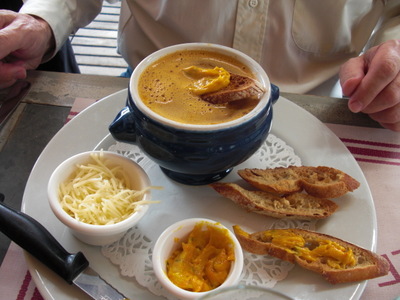
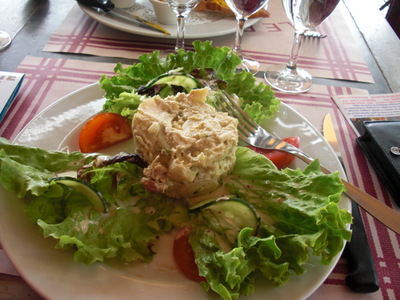 For lunch we settled at Bistro du Port, the clear choice for price and menu selection, and were pleased to see our choice seconded by quite a few local parties coming in for Mother's Day lunch.
For lunch we settled at Bistro du Port, the clear choice for price and menu selection, and were pleased to see our choice seconded by quite a few local parties coming in for Mother's Day lunch.Sunday, 25 May 2014: Narbonne, off to the coast on Mother's Day
Written 28 May
We made a much crisper start—David even got up in time to have breakfast at the hotel. We chose to spend the day visiting towns on the Mediterranean coast, which is mostly low and marshy but which turns out to be dotted here and there with ancient volcanoes! Who knew? That incredibly steep rock that Le Portanel was perched on had to be one of them.Anyway, we started with Sète, the farthest point in the excursion, which was actually two-thirds of the way back to Montpellier. It was apparently originally an island, a lone volcanic cone protruding from the sea, but is now joined to the mainland by two sandspits, a short one to the north and a very long skinny one linking it with the next town/volcano to the south, Agde and its suburb (on its own, smaller volcanic cone, projecting farther out into the Mediterranean) Cap d'Agde.
As usual, the GPS took us right into the center of the steep maze of one-way streets in Sète, where there was nowhere to park or even pull over, so we followed the one-ways until we could make it downhill toward the principal canal, where, as I had read, parking was available, then walked back up to the Office de Tourisme. On the way, we passed the central market, which was in full swing (one reason even the large parking garage under it was full), and David agreed to a short detour through it. He admired the cheese and baked goods, and even the butcher's stalls but waited in the food court while I took a turn through the seafood. Among the gastropods, they also had something called "poivres" (black peppers), which were about the same size as bulots and pointus but black in color and intermediate between them in spikiness. In this market, the pointus were labeled Murex, which I'm pretty sure is the genus name.
Sète, advertises boat rides. I was particularly interested in the yellow boat, a side-view glass-bottom that visits the local oyster parks, so that you can see the oysters and mussels being raised there, but I would have settled for the red boat, which tours the commercial and pleasure ports of the town then takes a loop out into the open Med, or the blue boat, which tours the canal system within the town. The same outfit operate the local Little White Train. Unfortunately, the yellow boat wasn't running at all (until July and August. David didn't want to do the red boat on such a windy day because his stomach was still unsettled. And the blue boat didn't run until late in the day and was completely without shade. The noon run of the white train didn't make its minimum of 10 people, and the next run was quite late, so we decided just to stroll around reading menus, eat lunch, and go on to Cap d'Agde, where David wanted to see the Musée de l'Éphèbe, on underwater archeology.

 For lunch we settled at Bistro du Port, the clear choice for price and menu selection, and were pleased to see our choice seconded by quite a few local parties coming in for Mother's Day lunch.
For lunch we settled at Bistro du Port, the clear choice for price and menu selection, and were pleased to see our choice seconded by quite a few local parties coming in for Mother's Day lunch.
David had Provençal fish soup with croutons, fiercly garlicky rouille sauce, and grated cheese (which he said was good but later gave him indigestion).
I had "octopus salad with potatoes and aioli," which I pictured, by analogy with a fish aioli, as a salad topped with chunks of octopus, chunks of potato, and a dish of aioli. Instead I got what you see on the right—some salad leaves and a neat cylinder of already mixed octopus slices, potato chunks, and aioli—and it was outstanding! The octopus was very tender, the potatoes cut small so the flavors could penetrate, and the sauce perfectly seasoned. You better believe I ate the whole thing!
To get to Agde and Cap d'Agde, we drove the long narrow sandspit south out of Sète. The lagoon was close on one side and the sea on the other, but we couldn't see either one because, on the lagoon side, the raised bed of the railroad paralleled the road and blocked our view, and on the sea side, tall banks of cane were just as opaque. Narrow as the dry land is, people are growing grapes out there, and there's even a winery!
In Cap d'Agde, David wanted to see the Musée de l'Éphèbe, a museum of underwater archeology, so we headed straight there, by road sign, as the GPS had never heard of it, and the brochure didn't give its street address. Signs took us to the Office de Tourisme, though, and the folks there gave us a local map and directed us to the museum. The museum turned out to be fascinating and took the rest of the afternoon, so we never tried to venture down to the waterfront—just as well, as a regatta was in progress, explaining why the town's ample parking was so full, even though the museum wasn't. Unfortunately, it's one of the few museums we've encountered on this trip that doesn't allow any photography, but you can Google it up and click "visite virtuel" to see many of the pieces.
On display were all the submerged archeological finds recovered from the rivers and coastal waters of the region, from shipwrecks to broken crockery thrown into rivers. This coast was already occupied by Gauls when the Greeks showed up—Agde was actually a Greek settlement, originally called "Agathé. The Romans came along later and were heavily influenced by the existing Greek civilization (Narbonne archeological sites show houses of Roman, centered on an atrium, and Greek, with a garden in front, design side by side), so the finds— which span many centuries are a mixture. Reading the labels, we learned an interesting new French usage; most of the objects listed the name of an "inventeur" (which means just what it looks like, "inventor"). We deduced that is must mean "discoverer," but I asked a docent to be sure. Yes, it's a specialized archeological usage, in which "inventor" means "person who added it to the inventory," i.e., discoverer.
The museum's crowning glory is the bronze statue of an "éphèbe," a Greek youth (or, more formally in Athens, a young man between 18 and 20 years of age and thus eligible for military service), thought to be the only ancient Greek statue ever found in French waters. It's life size or a little larger, and the museum's documentation makes a strong case for it's being a portrait of Alexander the Great. When it was discovered, the usual pressure was applied for it to be sent to the Louvre for restoration, and the discoverers and the city encountered the usual difficulty is getting it back again once the restoration was complete. After a 20-year battle for possession, it was returned on the condition that the city build a museum to house it and all the other artifacts, with the result that this museum opened in 1984. Highly recommended; if you're there during July or August, you can get a guided tour.
Back in Narbonne, we set off for our Mother's Day dinner. Mother's Day is apparently mostly a flowers and lunch-time thing in France, and we saw lots of lunching mothers and lots of flowers sold or being carried somewhere, but nothing like the besieged florists of Nancy in 2011. On Sunday evening around here, everything closes—our restaurant was only open because it was Mother's Day. Outside it's just labeled "Brasserie," but the menus call it "Le Quai des Artistes." (In fact, I found out looking for something else that at least two of the establishments we've patronized on that square, including Quai des Artistes, have changed hands and names since Google's street-view photo was taken in November of 2012. They probably haven't had time to get a new sign up outside.)
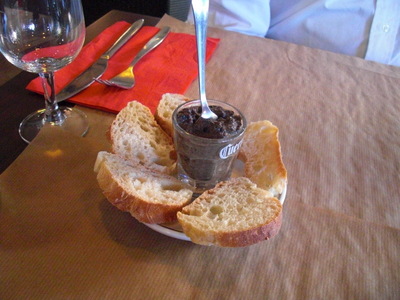
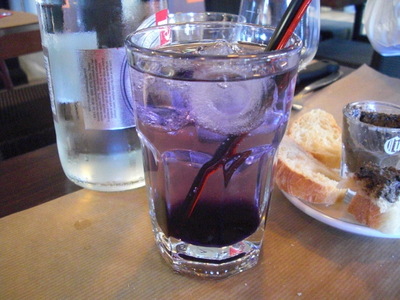 This little pot of black olive tapenade with toasts arrived while we studied the menus.
This little pot of black olive tapenade with toasts arrived while we studied the menus.
The place was offering a special Mother's Day menu (with two options for each course), which looked better than the regular choices, so we went with it. It included a complimentary kir (black currant liqueur mixed with white wine) to start with. I didn't want that, so I asked whether he could just top up the black currant liqueur with water, as though it were a fruit syrup. He misunderstood, apologized that he didn't have black currant syrup, but he could offer violet syrup instead . . . Whoa, way better! Yes, I'll have that, please. So he brought me a tall glass with one ice cube and an inch of violet syrup in the bottom, which I topped up from the water carafe. Yum! European violets are strongly scented, with an elusive aroma that's hard to describe, and they make a really good drink!
David just drank his kir.
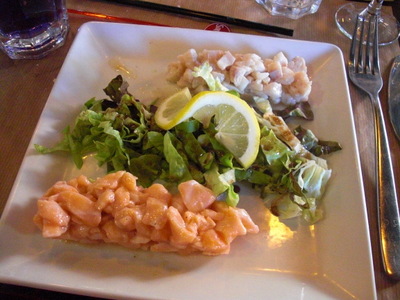
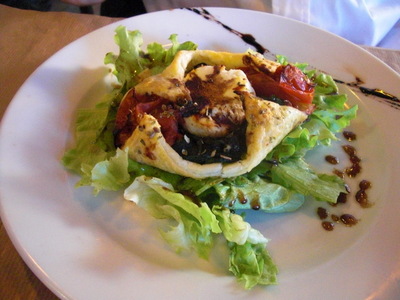 First course, David: A puff-pastry case filled with stewed spinach and goat cheese and baked. It was served on a bed of salad, decorated with roasted tomato wedges and a drizzle of balsamic. Very good. I'll have to try that at home.
First course, David: A puff-pastry case filled with stewed spinach and goat cheese and baked. It was served on a bed of salad, decorated with roasted tomato wedges and a drizzle of balsamic. Very good. I'll have to try that at home.
I had tartare of salmon and dorade, supposedly with ginger, but the ginger, in fact all the seasonings, were vanishingly subtle. A little salt and lemon helped. "Dorade" in that spelling could be any of several fishes (in three different genera!); only the daurade royale, in yet a fourth genus (Sparus aurata, gilthead seabream), can legally be spelled "daurade."
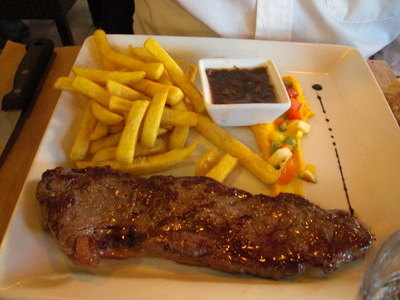
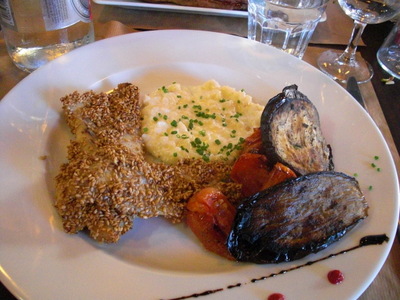 Main course, David: Grilled faux filet (sirloin steak) with pepper sauce, fries, carrot purée, and diced veggies. He said the steak was good but that the carrot purée was better.
Main course, David: Grilled faux filet (sirloin steak) with pepper sauce, fries, carrot purée, and diced veggies. He said the steak was good but that the carrot purée was better.
I had the other main-course choice, dorade (again spelled with an "o") thickly coated with sesame seeds and pan-fried, roasted eggplant and tomatoes, and a rich risotto. The veggies and risotto were excellent, but the fish and sesame less so. The sesame seeds were strangely tasteless.
I think David got the best of this menu.
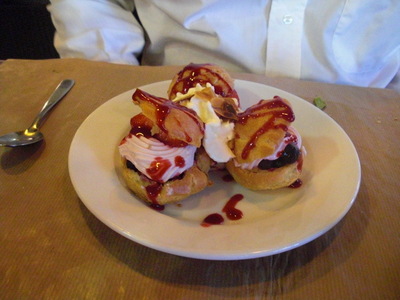
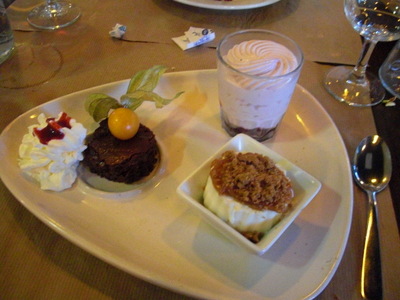 Dessert, David: "Profiteroles aux fruits rouges"—three small cream puffs filled with strawberry mousse and stewed red fruits—a variation on the usual puffs willed with vanilla ice cream and topped with chocolate sauce.
Dessert, David: "Profiteroles aux fruits rouges"—three small cream puffs filled with strawberry mousse and stewed red fruits—a variation on the usual puffs willed with vanilla ice cream and topped with chocolate sauce.
Dessert, me: An assortment of three small desserts—a disk of cake-like chocolate brownie with whipped cream and a Jerusalem cherry, a small glass with stewed red fruits topped with strawberry mousse, and a little free-standing panna cotta topped with a crispy streusel mixture. All quite good.
During the walk home along the Canal de la Robine, I was struck by a quartet of caryatids holding up a nearby house. They can't have been of much artistic or historical significance, as not even the driver of the little white train remarked on them. What caught my eye was their attitude; they strained, grimaced, bent, and writhed under their load. I thought of them as the kvetching caryatids, in sharp contrast to the serene and quiet dignity of the three female caryatids supporting a lintel on the city's most famous medieval house. Unfortunately, their dignity is somewhat impeached, I thought, because the house is universally referred to (and has been for centuries, I gather) as "la maison aux trois nourrices," the house of the three wet-nurses, because of their truly remarkable mammary endowments.